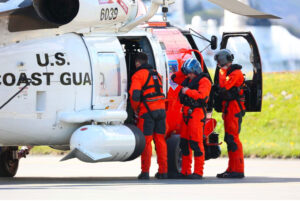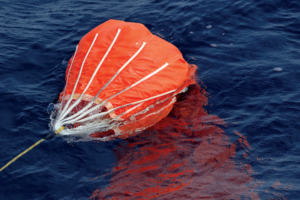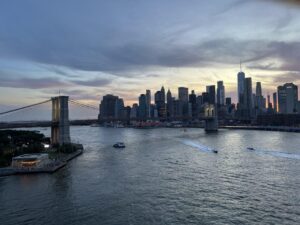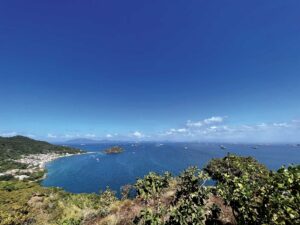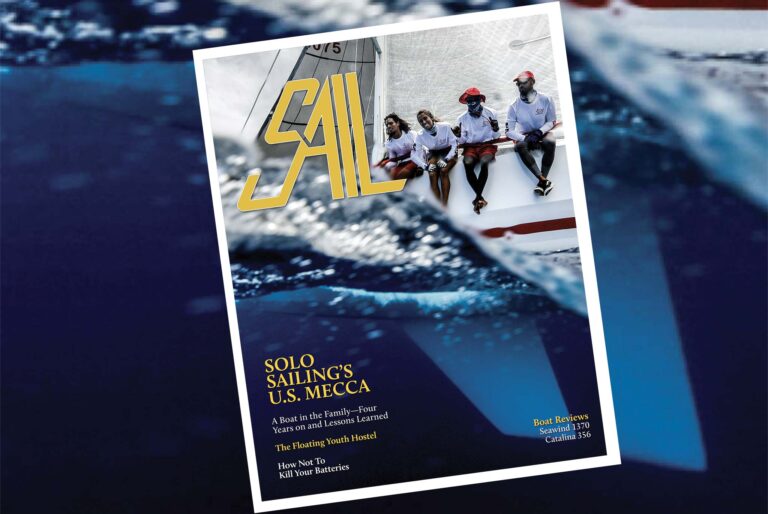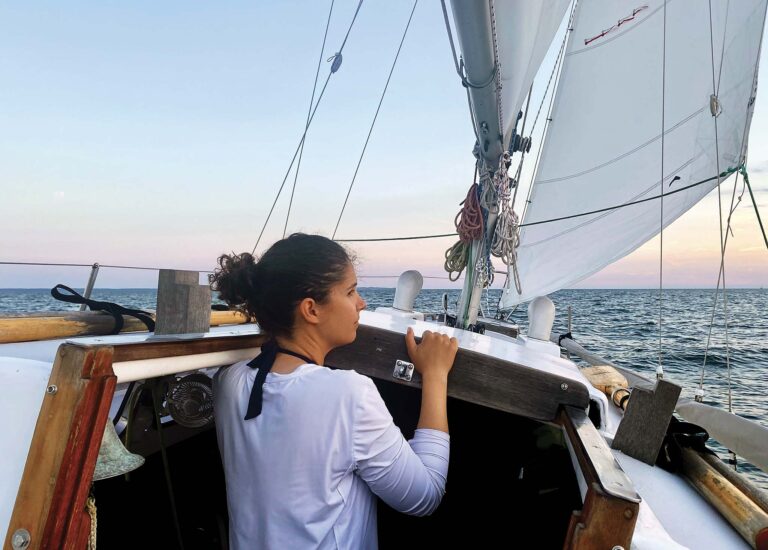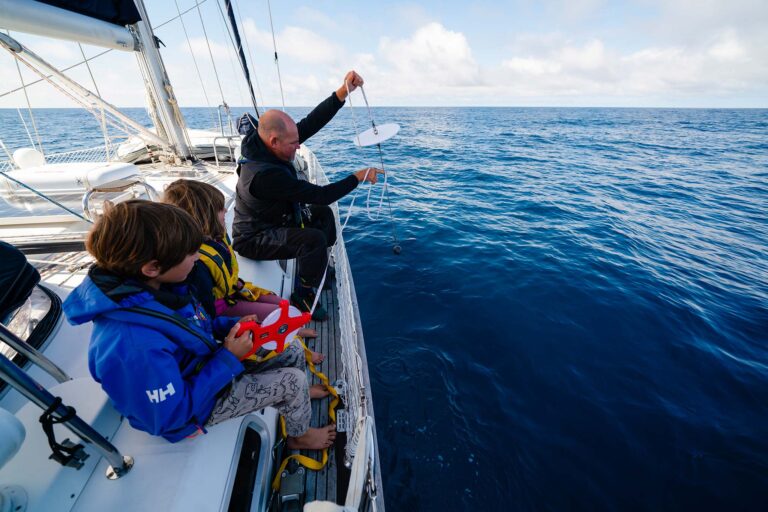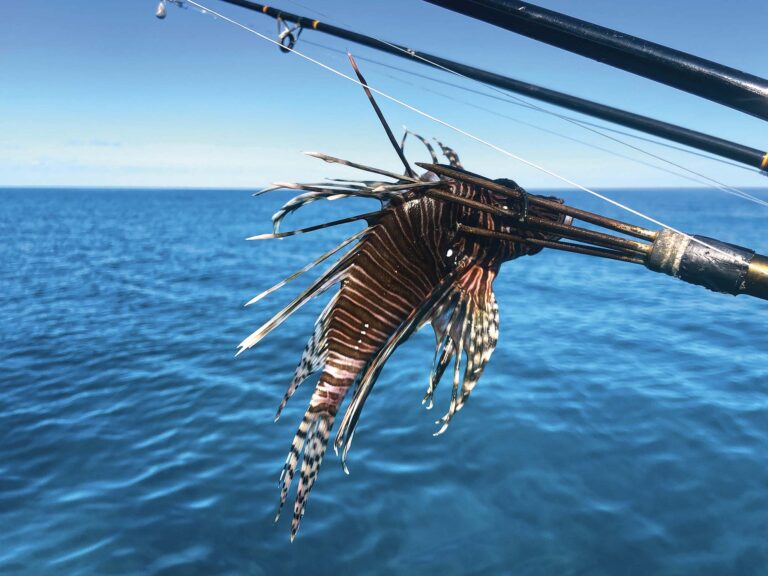
In October of 2018, Randall Reeves departed for a second attempt at what he called his “Figure 8 Voyage,” a solo circumnavigation of both the North and South American and Antarctic continents in one season. He had something to prove. During his first attempt, knockdowns off Cape Horn and in the Indian Ocean had damaged his 45ft aluminum sloop, Moli, or “Mo,” forcing an abrupt retirement and return home. The subsequent attempt went more smoothly, or at least as smoothly as anything can ever go sailing the stormy waters off Cape Horn…
Hour after hour we run toward the shallows to the south of Tierra del Fuego. Hour after hour the wind blows a steady 30 knots out of the west. The barometer remains fixed at 1008 millibars as I wait for the inevitable low. I already know full well what to expect. The pressure lines will trend east-west until a steep, slanting wave arrives from the north. With it will come more powerful winds. This latest wave and its attendant winds have been due for some time.
In the dark, I reach for the flashlight and train its beam on the barometer. The needle hasn’t moved. I count to three hundred, click the light on again. No movement.

I’ve already eaten my dinner directly from the pot and donned an extra layer of fleece. Now I am crammed into the starboard settee of the pilothouse, kitted-up in foulies and ready. I’m on weather watch and will remain so for the duration of the blow.
Click the light on again. My breath steams in a shaft of white. The barometer reads the same.
Mo is tearing along under heavily reefed working jib. Beyond her rails, night has consumed the sea, although not utterly. Often during a gale cloud obliterates both sea and sky. A graybeard is heard long before its boiling embrace emerges into the dim cast of Mo’s running lights. Tonight though, there is a full moon beyond the veil of clouds. The sky glows eerily, the heaving waves appearing as faint changes in shades of black. Thankfully, there’s not much to them. Not yet.
Click the light. Count and click again. A falling barometer will be the first sign our position within the low has changed. Still nothing.
This is a climax of sorts. It’s March 20, 2019. Day 167 of the Figure 8 Voyage. Three and a half months earlier, Mo and I had rounded Cape Horn from the north. The early morning had been cold and gray, with a strong westerly and spitting rain. The seas, though, were easy enough that Mo and I were able to slide in close enough to the great rock to kiss it on the shins, so to speak. After that it was on past Staten Island and the Falklands as we set out to sail around the entire Southern Ocean before returning for a second pass and then heading north toward the Arctic’s Northwest Passage.
The strategy this second time around—to stay as far south as I dared—had been chosen for two reasons. First, at my target latitude of 47 degrees south, the circumference of the circle from Cape Horn to Cape Horn would be almost 2,000 miles less than at the more typical “rounding” latitude of 40 degrees south. Second, farther south Mo would wallow in fewer calms. The continent-sized lows that wander endlessly through this part of the world tend to hoover-up everything around them, leaving vast windless spaces in between. The farther north one sails, the longer the calms; the farther south, the better the wind.
In fact, as fate would have it, lack of wind would most definitely not be a problem this time around. Scarcely a week after passing the cape, Mo and I were already well beyond the Falklands and bracing for our first major gale. Its winds built during the day but really came on overnight with the anemometer touching 45 knots and more. The main was down, the boom lashed to its crutch, the working jib deeply reefed. Still, the seas built. Near midnight, I was dozing fitfully in my bunk when I felt Mo lift up on a wave. After that came a heavy slam as green water roared into the cockpit, throwing itself against the companionway hatch. Mo rolled, and I rolled with her from my bunk onto the cupboards. As she righted, I could hear the tinkling and splashing of water in the pilothouse.

I groaned and wondered if we’d broken something vital. A year earlier, on my first Figure-8 attempt, such a sea had put out a window. Grabbing a flashlight, I crawled to the pilothouse. Water streamed off the windows and frames, but there was no shattered glass. In the cockpit, the dodger’s plastic door had ripped open and the windvane paddle was gone. It had, indeed, been a hard hit, but the wet belowdecks was merely from the sea squirting in around the edges of the companionway hatch. “Keep the water out,” was Eric Hiscock’s advice for those making a Southern Ocean passage. This can be rather more difficult than it sounds.
After that, the south dished up a succession of powerful lows, a gale a week on average. But Mo had weathered them all, and it appeared my decision to sail hard and fast through even the worst of them had paid off. Leave the storm jib in its bag had been the vow, and it had worked. Sitting in the pilothouse as we made for our second approach to Cape Horn, I was weary but also warmed by the glow of success. Or rather, near success. We still had this one last obstacle to overcome.
I click the light on again. The barometer has finally begun to waver. It now reads 1007mb. Within an hour the wind has veered into the northwest and increased to a standing 40 knots. On deck, I roll a fourth reef into the jib. A pelting rain bites my cheeks. I begin to wonder at the wisdom of my having decided to cut things as close as I have. When a prudent mariner speaks of their Cape Horn approach, it should be understood the actual target waypoint is south of a small group of islands known as Islas Diego Ramirez that are, themselves, some 50 miles south of the great cape itself.
The reason for the Diego Ramirez heading is water, or rather, a lack thereof. Sitting on the edge of the South American continental shelf, this group of rocks also marks where water depths rise abruptly from out of the abyss to as little as 300ft. In the relative shallows between Diego Ramirez and the cape, the seas will break with redoubled fury if ever the weather has been running foul to the west or if one should happen to encounter strong winds there. Of course, the likelihood of either is not insignificant and serves to concentrate the mind.

The most famous, early stories of yachts encountering difficulties here were those of Miles and Beryl Smeeton who, with John Guzzwell, attempted Cape Horn twice in their ketch, Tzu Hang. During the first approach in 1956, the yacht pitchpoled in steep and breaking seas. Beryl, on watch in the cockpit, was swept overboard. The gale took both masts, damaged the hull and left the boat half sunk. The saving of Tzu Hang on this occasion is a tale for the ages.
Since then, it has become customary for small vessels to plan a rounding of Cape Horn via the deeper water. If the weather looks favorable, as it was for Mo’s first pass, you can always alter course to the north. But even then you should only do so with caution. By midnight, the barometer reads 1005. Three hours later it’s down to 1003. The winds are now well over 40 knots. Seas are building. I have thoughts of bailing out, of jibing around for the run under Diego Ramirez, although the angle of wind and seas would now make that awkward as well. I carry on.
Dawn. We are above and beyond Diego Ramirez and racing over shoal water. However, it’s not the depth itself that worries me so much as the east-setting current that flows like a river around and around the Southern Ocean loop and must, necessarily, be shoved upward and accelerate as it meets these same shallows. At first there is no change. But as daylight comes on, the seas stack up and quickly double in size. Their blue-black faces become sheer. Their crests crash in on themselves with explosiveness that surpasses anything I’ve seen, even in all my weeks in the South. Mo is being thrown about like a toy. Frequently she surfs with a roar. Twice before 0800, she is laid over and scoops up a cockpit full of water. Both times she recovers. We race on.
I’m often asked why it is I am so attracted to long, offshore ventures. At first, the question caught me off guard, and my responses were halting. Wouldn’t anyone, given the opportunity, do everything they could to solo sail around the world? The answer, for me, at least, is an immediate, yes. For others, though, the first things that come to mind are the days of discomfort, the sleepless nights, the meals eaten from a can, the perpetual damp and gut-gnawing fear of an approaching storm, the inescapable wrath of a heavy sea, the months of exposure in a wilderness so remote the crew of the space station is one’s nearest neighbors. Thus it is that most choose not to go to sea and regard as crazy those who do.
What’s not to like about voyaging in the Southern Ocean?
Gauging the severity of yet another Southern Ocean low
Because so few human beings venture into the deep south, the wildlife there is unafraid
The first time round the weather was ideal for a close encounter with Cape Horn
For me, though, the Southern Ocean evokes an abiding interest for the simple reason the sailing here is like no other. It’s like exploring an alien world. Down here there isn’t any of the evidence of civilization you inevitably find among those other, more hospitable bodies of water to the north. Down here there are no other ships to be seen, no jet contrails overhead, no bits of plastic cluttering your wake. For months on end, there’s nothing even remotely resembling a lee shore. The waves, freed from such constraints, roam like giant buffaloes over a great, blue plain.
Similarly, down here, the animals you encounter live in such a purity of wilderness you are likely the first human they’ve ever seen. Many days Mo and I are visited by that marvel, the Wandering Albatross. As big as a suitcase and with a 12ft wingspan, the bird lives most of its life beyond the sight of land, and most of that time is spent aloft. It can glide in any direction in any kind of wind. So adapted is it to its environment, it can even sleep while airborne. When my little ship is struggling to survive, an albatross will hover nearby with an effortlessness that defies understanding. There, above that crashing waves, it floats, so poised, so still as to seem carved out of the sky.
Then there are the stars. Down here on a clear, moonless night the heavens shine with such brightness our brother constellations recede into the melee of twinkling and are ultimately lost. On such a night, looking upward with binoculars is like dipping your hands into a basket of pearls, even as galaxies of phosphorescence spin in Mo’s wake.
You ask me why? With my own eyes, I have seen these things. That is why.
The low is due to blow itself out by early morning, but at 1100 the winds are still 35 knots and gusting higher. We are below the peninsula now with Cape Horn several hours farther east. I let Mo ease north to meet it. Though the cloud above us is beginning to thin, the coast is enshrouded in fog. It, therefore, comes as a surprise when, just after making the noon log, I sight land: a lone, dark hump of the port beam, Cape Spenser.
On we rush in the mad seas, but the low is moving past, and the day has become fine and bright. Finally, just after 1500, Cape Horn heaves into view two points off the port bow, awash in sunlight. Even at a distance, I can see the breakers throwing themselves at her feet: gray, hulking rock, not so much barren as raw, jagged and torn from eons of facing the worst.
It has been 110 days since we last saw this rock, looping around with the express purpose of seeing it again. In that time Mo has sailed more than 15,000 miles nonstop in the heart of the Roaring Forties. What should I feel? Proud of the accomplishment? Humbled by the privilege of exploring so long these timeless and trackless seas? Lucky to have survived with boat and self intact?
Yes, all that, but not now. For now, I only feel the relaxation of fatigue, of relief and release. After two tries the circuit is closed. The wind is easing, but I leave the reefs in. I make a hot dinner and go to my bunk for a long dreamless sleep. Under a night sky ablaze with the cold, blue light of the stars, Mo sails on and on and on…
Ed Note: For the complete story of Randall Reeves’ voyage around Antarctica and North and South America, visit figure8voyage.com. Reeves recently published a photo book of his voyage, available on his website, and is working on a second book. In recognition of Reeves’ accomplishment, the Ocean Cruising Club (oceancruisingclub.org) awarded him the 2019 Barton Cup, the organization’s premier annual award
Photos by Randall Reeves
March 2021






